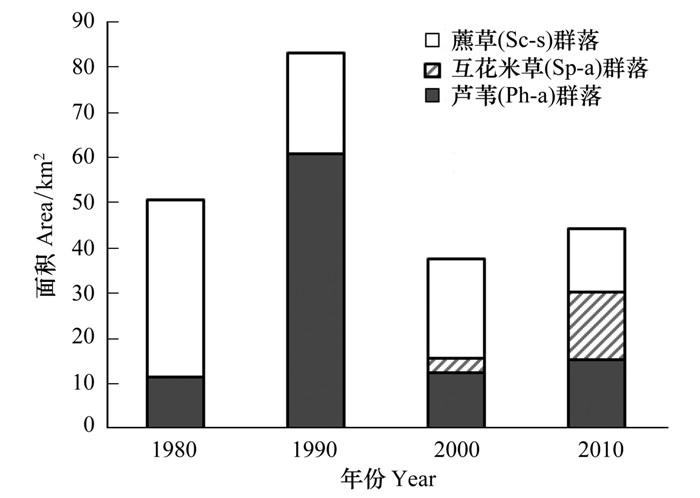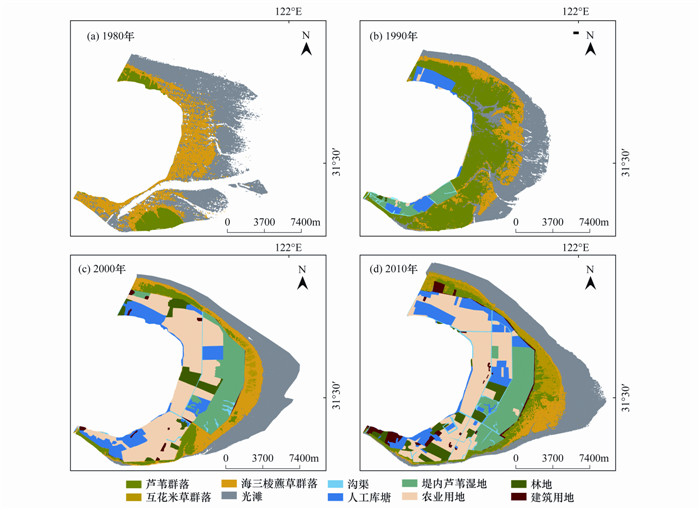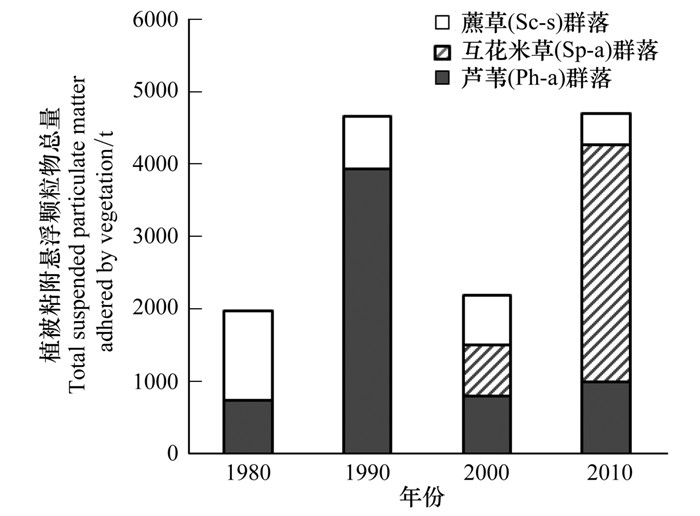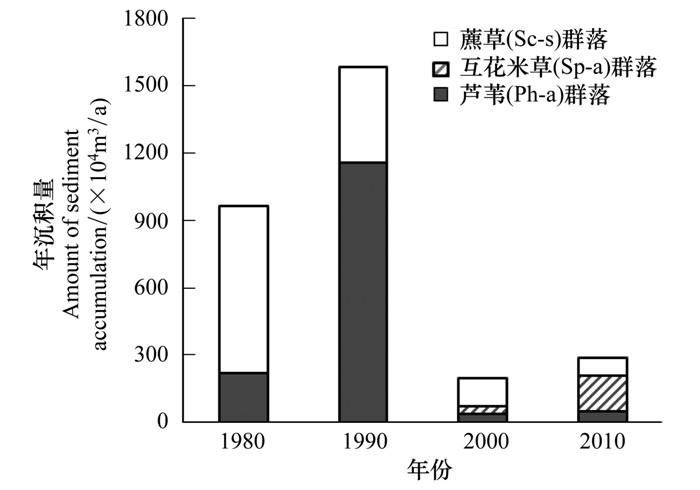文章信息
- 任璘婧, 李秀珍, 杨世伦, 闫中正, 黄星
- REN Linjing, LI Xiuzhen, YANG Shilun, YAN zhongzheng, HUANG Xing
- 崇明东滩盐沼植被变化对滩涂湿地促淤消浪功能的影响
- The impact of salt marsh change on sediment accumulation and wave attenuation at the East Chongming Island
- 生态学报, 2014, 34(12): 3350-3358
- Acta Ecologica Sinica, 2014, 34(12): 3350-3358
- http://dx.doi.org/10.5846/stxb201311042665
-
文章历史
- 收稿日期:2013-11-4
- 修订日期:2014-4-1
河口滩涂湿地是陆地与海洋之间物质能量交换的重要环节,潮汐、盐淡水交汇、冲淤演变、植被演替等等各种物理、化学和生物过程在这里相互作用,形成了一个复杂的系统,是综合多学科研究的热点与难点[1]。崇明东滩滩涂湿地具有气候调节、物质生产、净化环境、生物多样性保育等重要生态系统服务功能[2]。除此之外,随着经济的发展,土地资源不足,滩涂湿地盐沼植被促淤消浪等对海岸沉积动力过程的影响,在海平面上升背景下,日益受到国内外研究者的高度重视[3, 6]。滩涂盐沼植被是粗糙下垫面,可增大水流摩擦阻力,减缓水流,影响泥沙运输,达到促淤消浪的作用,这对于滩涂水沙动力环境,冲淤演变以及滩涂发育有多重意义:植被黏附水体中悬浮颗粒物有助于净化水质,植被促进泥沙淤积有利于滩涂湿地维持,植被消浪缓流作用保证了海堤安全[1, 6, 7]。
近年来,大规模的滩涂围垦、外来物种互花米草(Spartina alterniflora)入侵等自然人为因素对崇明东滩景观格局造成了巨大影响[8, 9, 10]。盐沼植被群落结构的改变造成了一系列的生态效应,植被促淤、消浪功能的巨大变化就是其中最重要的两项。研究自然滩涂湿地植被结构对其功能造成的影响,既是对“景观格局—过程”关系研究的贡献,也有助于更好地了解盐沼植被的多重生态功能,为今后的围垦与保护提供决策依据。
1 研究区域与方法崇明东滩位于上海市崇明岛最东端(31°26′—31°37′ N、121°46′—122°02′ E),长江入海口处。由长江径流携带的泥沙沉积而成[1]。研究区为1980年、1990年、2000年、2010年卫星影像上提取的海堤以外的自然滩涂区域,南起奚家港北至北八滧港(图 1)。崇明东滩地属亚热带季风气候,全年气候温和、空气湿润、四季分明。年均温度15.3℃,7—8月份最热,月平均气温达到27.8 ℃,1月份最冷,月平均气温仅为3.5 ℃,年均降雨量1100—1200 mm。长江大通站1951—2010年年均径流量达9000亿m3,年均输沙量4.1亿t[11, 12]。1990年代后,受长江流域修建水库以及水土整治工程的影响,长江入海输沙量近年已减少至1.5亿t[13, 14],使河口区地貌的冲淤格局发生了较大的变化[15]。长江河口处于非正规半日浅海潮流区,崇明东部潮滩多年平均潮差为2.50 m左右[16]。

|
| 图 1 研究区域示意图 Fig. 1 The study area |
崇明东滩主要分布3种典型盐沼植被群落:藨草(Scirpus spp.)群落、互花米草(Spartina alterniflora)群落以及芦苇(Phragmites australis)群落。藨草群落主要包括海三棱藨草(Scirpus mariqueter)、糙叶苔草(S. scabrifolia)和藨草(S. triqueter),它们在盐度、潮位不同的滩地,形成单优势或混合群落。因高度、密度、外貌特征等相似,统称为藨草群落。20世纪90年代中后期互花米草引入以前,崇明东滩盐沼植被先锋物种海三棱藨草主要分布在中潮滩,芦苇群落分布在高潮滩。互花米草人工引种并成功定居之后,逐渐扩散,侵占芦苇和藨草群落生态位,形成相互竞争的局面,严重排挤了土著种的生长,逐渐成为研究区的优势物种之一[17]。互花米草入侵对无脊椎动物群落、涉禽种类和数量、鱼类生境以及滩涂自然环境等均造成了一定的负面影响[18]。但是互花米草高生产力、固堤护岸、消浪促淤、围垦造陆等正面生态功能也不容忽视。
近年来,崇明东滩主要进行了3次大围垦: 1990—1993年围垦了60.77 km2;在1996—1997 年和1998—1999年分别围垦了9.14 km2 和23.13 km2,2001年在崇明岛南部再次围垦约6 km2[9]。大面积的堤外滩涂湿地不断被人工围垦后用作人工库塘、农业用地、建筑用地等,也有一部分仍为半自然状态下的堤内湿草甸。
1.2 数据来源本文使用的四期卫星影像数据分别为:1980年10月27日MSS数据(分辨率79m)、1990年12月4日、2000年6月14日TM数据(分辨率30m)以及2010年2月21日北京一号小卫星影像数据(分辨率32m)。通过Erdas9.3和Arcgis10.0,分别对堤内和堤外部分进行监督分类和目视解译,野外实地考察和走访后,对解译结果进行了修订,最终得到4个时期的景观类型分布图。其中光滩部分,由于每幅遥感影像拍摄时的潮位不同,潮间带下部光滩面积可能存在一定误差,在解译过程中已经与潮位表、海图等进行过校正,尽量减小此部分误差。经分类精度评价,多期影像解译精度均达到85%以上。根据解译结果统计的各植被群落分布面积见图 2。
1.3 植被黏附悬浮颗粒物计算方法根据Li等[12]对崇明东滩3种典型植被芦苇、互花米草、海三棱藨草黏附悬浮颗粒物的差异性研究,单位滩地面积的互花米草群落总黏附量为(220.6±172.7) g·m-2·a-1,明显高于相邻芦苇群落(64.9±38.1) g·m-2·a-1和海三棱藨草群落(31.6±10.0) g·m-2·a-1。再结合解译出的植被面积,估算30年来崇明东滩3种典型盐沼植被群落黏附悬浮颗粒物总量变化趋势。
1.4 植被促淤功能计算方法根据杨世伦等在2008—2012年对崇明东滩3条断面沉积速率月测量记录,总结出芦苇群落、互花米草群落、海三棱藨草群落年沉积速率分别为(29.4±27.4)、(108.7±80.6)、(57±47) mm/a[19]。但由于互花米草自身累积沉积物的能力较强,其引种后分布面积不断扩张,破坏了植被原有的分带性,减少其他靠岸生长植被的沉积速率[20]。根据刘英文等研究,崇明东滩1982—1990年滩面(包括光滩)平均沉积速率为190mm/a[21]。通过遥感数据解译结果,估算不同年份不同类型植被沉积量以及总的沉积量。
1.5 植被消浪功能计算方法Yang等在崇明东滩连续观测潮汛期不同水深不同植被带对波高波能的消减速率,研究发现光滩、海三棱藨草、互花米草对波高的消减率分别为0.091%/m、0.95% /m和1.3%—6.0%/m[22, 23]。数据均在正常潮汛情况下测得。因芦苇与互花米草在高度、密度、生物量等植被形态上均较类似,我们假设芦苇消浪能力与互花米草相同,估算出不同覆盖类型将有效波高消减为0.01 m以下所需要的宽度。陈燕萍等研究发现,崇明东滩中部中潮滩潮周期平均有效波高为(0.13±0.09) m,在向岸强台风和大潮高潮位阶段,崇明东滩中潮线附近的最大波高可达1.5—2 m[24]。Tom Ysebaert等在崇明东滩潮汛期,并伴有向岸强风的情况下,测到最大水深1.86 m,最大波高0.64 m,此时海三棱藨草群落已完全被淹没,消浪能力已几乎为零,监测不到,互花米草也已大部分被淹,消浪能力有限[22]。那么在波高2 m的风暴潮情况下,可以推断光滩、海三棱藨草群落几乎没有消浪能力,互花米草消浪能力也非常有限。根据史本伟等在日常测得的每米互花米草能消除有效波高4.4×10-3m,可以保守推断,要消除2 m的波高,所需要的互花米草群落或芦苇群落最小宽度[7]。用Arcgis10.0测量堤外不同植被类型分布宽度后,可以估算出不同年份堤外没有足够植被保护的岸段长度。
2 结果与分析由于长江河口水沙变化,河床冲淤变化,围垦工程实施,以及外来物种互花米草的入侵、植被自然演替等,堤外自然湿地30年来植被组成与面积均发生了巨大变化。1980年、1990年、2000年、2010年,有植被覆盖的自然湿地面积分别为51、83、37、44 km2 (图 2),芦苇、互花米草、藨草3种主要盐沼植被群落面积比例分别为23 ∶ 0 ∶ 77、73 ∶ 0 ∶ 27、33 ∶ 9 ∶ 58、34 ∶ 34 ∶ 32。其中,土著先锋藨草群落由1980年最多时的39 km2减少到2010年的14 km2。芦苇群落由最多时的60 km2减少到2010年的15 km2。

|
| 图 2 崇明东滩3种典型盐沼植被群落面积变化 Fig. 2 The area change of three typical salt marsh communities in East Chongming |
相反,外来物种互花米草却由1980年、1990年的0km2,不断增加到2000年的3km2以及2010年的15 km2,扩张迅速,到2010年已成为分布面积最大的盐沼植被之一。
从植被前沿扩展速率来看,1980—1990年约为180 m/a,1990—2000年为280 m/a,2000—2010年为190 m/a。因此,1990—2000年扩展速率最快,与这段时间的高强度围垦相呼应。但堤外自然植被的实际面积却以2000年最低(图 2)。因此,围垦虽然促进了盐沼植被的快速东扩,但难以弥补由此带来的面积损失。

|
| 图 3 崇明东滩滩涂湿地类型分布图 (1980—2010年) Fig. 3 The classification map of the estuary wetlands in East Chongming (1980—2010) |
植被黏附悬浮颗粒物总量30年来的变化见图 4,总体上呈现波动态势。1990年时植被总黏附悬浮颗粒物量最大,达到4645 t,2000年最少,为2192 t,不到1990年最高时的二分之一。其中藨草群落黏附量由1980年的1237 t减少到2010年444 t,芦苇群落除1990年时达到3936 t,占1990年总量的85%外,其他年份相差不大,互花米草群落却由0 t迅速增加到3265 t,占2010年总量的70%。究其原因,1980—1990年间,伴随着滩面淤高迅速,尤其是高潮滩不断向外淤涨,盐沼植被面积不断扩大,尤其是芦苇群落,而芦苇黏附悬浮颗粒物能力更是海三棱藨草的1.5倍左右,因此植被黏附悬浮颗粒物总量增加了近1倍[6]。1990—2000年,东滩一共经历了3次大规模的围垦,滩涂面积不断缩小,大面积的芦苇群落被围进大堤内,导致堤外盐沼植被黏附悬浮颗粒物总量迅速减少[9]。2000—2010年,是外来物种互花米草的快速增长期,而互花米草黏附悬浮颗粒物的能力远远大于其他两个土著种,几乎是芦苇、海三棱藨草的3.5倍和5倍,因此10年间植被黏附悬浮颗粒物总量大大增加,2010年已到达2000年的2倍多。

|
| 图 4 30年来植被黏附悬浮颗粒物总量变化 Fig. 4 The change of total suspended particulate matter adhered by vegetation |
随着分布面积的变化,3种典型盐沼植被群落年沉积量也发生了巨大变化(图 5)。互花米草引种以及大面积人工围垦之前的1980年、1990年崇明东滩盐沼植被年沉积量分别达到960万m3和1579万m3,由于芦苇面积的增加,1990年沉积量增加了39%。然而,1990—2000年93km2的滩涂湿地(包括光滩)遭到了人工围垦,比1990年崇明东滩有植被覆盖的滩涂湿地总面积还要多10 km2,因此2000年盐沼植被年沉积量减少到195万m3,仅占1990年的12%。到2010年,随着互花米草入侵面积增加,盐沼植被年沉积量增加到286万m3。

|
| 图 5 30年来盐沼植被年沉积量变化 Fig. 5 The estimated change in sediment accumulation in the last thirty years |
藨草群落年沉积量由1980年的743万m3不断减少到2010年的80万m3,芦苇群落在1990年时年沉积量最高达1152万m3,到2010年降至45万m3,而互花米草群落年沉积量却由0 m3迅速增加到2010年的161万m3,占到2010年植被带沉积总量的56%。这些变化与植被促淤能力的大小,以及分布面积的变化密切相关。互花米草群落植被覆盖密集、茎秆结实、枝叶繁茂,其多年平均沉积速率分别是芦苇群落、海三棱藨草群落的3.7倍和1.9倍[19]。
根据唐玉姝等在崇明东滩南断面(海岸冲刷带,有促淤坝)和北断面(海岸淤涨带,无促淤坝)测得的土壤容重平均值1.46 g/cm3[25],可估算出1980年、1990年、2000年、2010年盐沼植被年平均沉积量分别为14.02×106 t/a、23.05×106 t/a、2.85×106 t/a、4.17×106 t/a。然而1980—2010年,植被黏附悬浮颗粒物总量年平均值分别为1976.37 t/a、4645.27 t/a、2192.24 t/a、4695.34 t/a,分别仅占沉积量的0.01%、0.02%、0.08%、0.11%,呈不断上升趋势。虽然植被黏附悬浮颗粒物量占年沉积量的比例相对较小,但其促进悬浮颗粒物沉降的作用仍不容小觑[6, 12]。
2.4 盐沼植被消浪能力变化在常规波高情况下(0.13±0.09 m),如果使浪高降低为0,光滩至少需要5058 m宽,海三棱藨草至少需要482 m宽,互花米草至少需要74—352 m宽,芦苇至少需要74—352 m宽,植被越高、越密,植被带越宽其消浪缓流能力越高[20]。根据史本伟等的观测数据[7],保守推断在风暴潮情况下,要消除2 m的波高,至少需要互花米草或芦苇群落450 m。据此推算发现,常规波高情况和风暴潮情况下,堤外没有足够植被保护的岸段长度变化趋势基本一致(图 6)。1990年时这样的岸段长度均最少,常规波高情况下为0 km,风暴潮情况下为5 km;2000年时存在风险的岸段最长,分别达到7 km和26 km,增加了7 km和21 km。这是因为1990年时堤外芦苇群落分布最广,而由于1990—2000年的多项围垦工程,大面积芦苇湿地被围入堤内,堤外植被分布面积有限;到2010年随着滩涂向海逐渐淤涨,植被扩张,问题有所缓解,常规波高情况和风暴潮情况下,堤外没有足够植被保护的岸段长度分别减少到6 km和20 km。

|
| 图 6 30年来堤外没有足够植被保护的岸段长度变化 Fig. 6 The estimated change of seawall without enough salt marsh vegetation protection in the last thirty years |
通过估算1980—2010年崇明东滩盐沼植被变化对滩涂湿地促淤消浪功能的影响(表 1),虽然盐沼植被粘附悬浮颗粒物量增加了138%,但其占沉积量的比例仅为0.1%左右,而年沉积量在这30年却减少了70%,所以滩涂湿地促淤能力30年来呈下降趋势。1980—2010年,不论在常规波高情况下还是风暴潮情况下,堤外没有足够植被保护的岸段长度均有所增加。综上所述,崇明东滩滩涂湿地促淤能力和消浪能力1980—2010年均呈下降趋势。
| 生态系统服务功能 Ecosystem services | 年度 Year | 变化量 Net change | % | ||
| 名称 Name | 相应内容 Corresponding contents | 1980 | 2010 | ||
| 促淤能力 | 黏附悬浮颗粒物量/t | 1976 | 4695 | +2719 | +138 |
| Sediment accumulation | 沉积量/106 t | 14.02 | 4.17 | -9.85 | -70 |
| 消浪能力(不安全岸线长度) | 常规波高情况/km | 5 | 6 | +1 | +20 |
| Wave attenuation (Length of unsafe seawall) | 风暴潮情况/km | 19 | 20 | +1 | +5 |
3 0年来,在自然与人为因素的共同作用下,堤外自然滩涂湿地景观格局发生了巨大变化[26]。人类围垦和外来物种互花米草入侵就是其中两个最主要的影响因素。研究发现虽然近30年崇明东滩围垦面积大于100 km2[9],但有植被覆盖的滩涂湿地面积仅比1980年减少了7 km2(14%)。正是由于植被巨大的促淤消浪功能,滩涂湿地才得以维持并继续发育。
其中,外来物种互花米草就功不可没。互花米草根系发达,耐盐耐水淹,繁殖能力、扩张能力强,排斥其他植物生长,在与芦苇、海三棱藨草的生态位竞争中常常处于优势,导致其面积自入侵以来不断扩大[10]。植被群落结构的变化引发了一系列的生态效应。外来物种互花米草入侵破坏鱼类、鸟类、底栖动物等的生境,不利于生物多样性保育,危害滩涂自然环境及生态系统平衡[18, 27]。但是互花米草植株高大茂密、抗逆性强,有利于促淤造陆、固堤护岸[21]。到2010年,互花米草以其34%的植被面积,对黏附悬浮颗粒物量与促淤量的贡献已分别占到总量的70%和56%,均大于本土物种芦苇与藨草群落。
由于诸多条件的限制,估算过程中也存在着一些不足。
植被黏附悬浮颗粒物能力与许多外界因素密切相关,如河口地区悬沙浓度变化、淹水时间频率等等。Li等[28]研究发现,1990—2010年20年间,由于流域人类活动影响,长江入海泥沙大量减少,河口地区局部悬沙浓度下降了约55%,这必然会对植被实际黏附悬浮颗粒物量产生一定影响。但据其他文献报道,由于在人类活动以及波浪和潮流共同作用下,产生了泥沙再悬浮等现象,海床的侵蚀不断地补充悬沙[14]。因此长江河口区域悬沙浓度是否减小仍存在较大争议,有待于进一步明确[29]。且由于植被黏附悬浮颗粒物仅有2005—2007年的数据,研究其与河口地区悬浮泥沙浓度的关系有一定困难,因此还需要细致深入地针对此进行试验来完善。
此外李华[6]等研究发现,植被黏附悬浮颗粒物量不仅有植被类型差异,还有位置、垂向与时间差异,随着距光滩或潮沟距离增加,悬浮颗粒物含量减小,植被黏附量就降低;随着淹水时间频率增加,黏附量从植物顶端向基部增加;随着植被生物量增加,黏附量增加,在9月份达到饱和。不同植被类型的垂向淤积速率也有类似的时空变化,本研究只考虑了不同植被类型的平均黏附量和淤积量,以后还需要进一步分析植被空间分布对促淤功能估算结果的影响。
由于有关早期崇明东滩不同植被类型沉积速率的资料有限,因此采用了包括光滩在内的平均沉积速率,可能会相对高估1980年以及1990年盐沼植被分布区的沉积量。
本研究中所采用的植被对有效波高的消减数据均是在日常情况下测得,并未获得风暴潮来临时不同植被对波高的消减数据。当风暴潮来临,水深加深,植被大部分甚至全部被淹没时,植被对有效波高的消减作用会大幅降低[22]。因此本文趋于低估了风暴潮来临时堤外没有足够植被保护的岸段长度。
4 结论在自然与人为因素共同作用下,30年来盐沼植被群落结构发生了巨大变化,导致崇明东滩滩涂湿地促淤能力和消浪能力1980—2010年均呈下降趋势。1980—1990年随着滩涂淤涨,植被黏附悬浮颗粒物总量、沉积量以及植被消浪功能均迅速提高;1990—2000年伴随着大规模围垦工程,堤外滩涂植被大面积减少,促淤消浪功能也快速降低;2000—2010年随着滩涂不断淤积以及互花米草快速扩张,盐沼植被促淤消浪功能有所增加。因此,在围垦大堤之外保持一定面积、宽度的盐沼植被,不但有利于各项生态功能的发挥,更有利于保障堤内的安全。
| [1] | Ji X Q. A Study on Characteristics of Hydrodynamics and Sediment Transport, and Analysis of Vegetation Effects in Chongming Dongtan, Yangtze Estuary. Shanghai: East China Normal University, 2008. |
| [2] | Wu L L, Lu J J, Tong C F, Liu C Q. Valuation of wetland ecosystem services in the Yangtze River estuary. Resources and Environment in the Yangtze Basin, 2003, 12(5): 411-416. |
| [3] | Bouma T J, De Vries M B, Low E, Kusters L, Herman P M J, Tánczos I C, Temmerman S, Hesselink A, Meire P, Regenmortel S V. Flow hydrodynamics on a mudflat and in salt marsh vegetation: identifying general relationships for habitat characterisations. Hydrobiologia, 2005, 540(1/3): 259-274. |
| [4] | Coulombier T, Neumeier U, Bernatchez P. Sediment transport in a cold climate salt marsh(St. Lawrence Estuary, Canada), the importance of vegetation and waves. Estuarine, Coastal and Shelf Science, 2012, 101: 64-75. |
| [5] | Moskalski S M, Sommerfield C K. Suspended sediment deposition and trapping efficiency in a Delaware salt marsh. Geomorphology, 2012, 139-140: 195-204. |
| [6] | Li H, Yang S L. Changes of suspended particulates adhering to salt marsh plants. Acta Oceanologica Sinica, 2010, 32(1): 114-119. |
| [7] | Shi B W, Yang S L, Luo X X, Xu X J. A wave attenuation over the transitional zone of mudflat and salt marsh a case study in the eastern Chongming on the Changjiang Delta. Acta Oceanologica Sinica, 2010, 32(3): 174-178. |
| [8] | Huang H M, Zhang L Q, Yuan L. The spatio-temporal dynamics of salt marsh vegetation for Chongming Dongtan National Nature Reserve, Shanghai. Acta Ecologica Sinica, 2007, 27(10): 4166-4172. |
| [9] | Gao Y, Zhao B. The effect of reclamation on mud flat development in Chongming Island, Shanghai. Chinese Agricultural Science Bulletin, 2006, 22(8): 475-479. |
| [10] | Xiao D R, Zhang L Q, Zhu Z C. The range expansion patterns of Spartina alterniflora on salt marshes in the Yangtze Estuary, China. Estuarine, Coastal and Shelf Science, 2010, 88(1): 99-104. |
| [11] | Zhang E F, Savenije H H G, Chen S L, Chen J Y. Water abstraction along the lower Yangtze River, China, and its impact on water discharge into the estuary. Physics and Chemistry of the Earth, Parts A/B/C, 2012, 47-48: 76-85. |
| [12] | Li H, Yang S L. Trapping effect of tidal marsh vegetation on suspended sediment, Yangtze Delta. Journal of Coastal Research, 2009, 25(4): 915-924. |
| [13] | Yang S L, Zhang J, Zhu J, Smith J P, Dai S B, Gao A, Li P. Impact of dams on Yangtze River sediment supply to the sea and delta intertidal wetland response. Journal of Geophysical Research: Earth Surface, 2005, 110(F3): F03006. |
| [14] | Yang S L, Zhu J, Li M. Evolutional trend of the coastal wetland in Shanghai in response to decrease of sediment supply from the Changjiang River. Journal of Marine Sciences, 2009, 27(2): 7-15. |
| [15] | Li P, Yang S L, Dai S B, Zhang W X. Accretion/erosion of the subaqueous delta at the Yangtze Estuary in recent 10 years. Acta Geographica Sinica, 2007, 62(7): 707-716. |
| [16] | Zhao C Q, Mao Z C, Yu Z Y, Xu H G, Li J F. The analysis of the eastern Chongming tidal flats evolution in the Yangtze River estuary. Transactions of Oceanology and Limnology, 2008, (3): 27-34. |
| [17] | Li H P, Zhang L Q, Wang D H. Distribution of an exotic plant Spartina alterniflora in Shanghai. Biodiversity Science, 2006, 14(2): 114-120. |
| [18] | Chen Z Y, Li B, Zhong Y, Chen J K. Local competitive effects of introduced Spartina alterniflora on Scirpus mariqueter at Dongtan of Chongming Island, the Yangtze River estuary and their potential ecological consequences. Hydrobiologia, 2004, 528(1/3): 99-106. |
| [19] | Li X Z, Ren L J, Liu Y, Christopher C, Vlo M, Yang S L. The impact of the change in vegetation structure on the ecological functions of salt marshes: the example of the Yangtze estuary. Regional Environmental Change, 2014, 14(2): 623-632. |
| [20] | Yang S L, Li H, Ysebaert T, Bouma T J, Zhang W X, Wang Y Y, Li P, Li M, Ding P X. Spatial and temporal variations in sediment grain size in tidal wetlands, Yangtze Delta: on the role of physical and biotic controls. Estuarine, Coastal and Shelf Science, 2008, 77(4): 657-671. |
| [21] | Liu Y W, Yang S L, Luo X X. Separation estimate of beach erosion and deposition on intertidal wetland of the sea level rise and the normal deposition. Shanghai Land & Resources, 2011, 32(3): 18-22. |
| [22] | Ysebaert T, Yang S L, Zhang L Q, He Q, Bouma T J, Herman P M J. Wave attenuation by two contrasting ecosystem engineering salt marsh macrophytes in the intertidal pioneer zone. Wetlands, 2011, 31(6): 1043-1054. |
| [23] | Yang S L, Shi B W, Bouma T J, Ysebaert T, Luo X X. Wave attenuation at a salt marsh margin: a case study of an exposed coast on the Yangtze Estuary. Estuaries and Coasts, 2012, 35(1): 169-182. |
| [24] | Chen Y P, Yang S L, Shi B W, Li P, Zhu J R. Temporal and spatial variations in wave height over intertidal mudflats and the influencing factors: a case study from the Yangtze River Delta. Advances in Marine Science, 2012, 30(3): 317-327. |
| [25] | Tang Y S, Wang L, Jia J W, Li Y L, Zhang W Q, Wang H L, Fu X H, Le Y Q. The effect of artificial disturbance such as siltation promotion on soil microbial respiration of tidal wetlands in the Yangtze River estuary. Acta Ecologica Sinica, 2010, 30(18): 5022-5032. |
| [26] | Li J F, Dai Z J, Ying M, Wu R R, Fu G, Xu H G. Analysis on the development and evoluation of tidal flats and reclamation of land resource along shore of Shanghai city. Journal of Natural Resources, 2007, 22(3): 361-371. |
| [27] | Li B, Liao C Z, Zhang X D, Chen H L, Wang Q, Chen Z Y, Gan X J, Wu J H, Zhao B, Ma Z J, Cheng X L, Jiang L F, Chen J K. Spartina alterniflora invasions in the Yangtze River estuary, China: an overview of current status and ecosystem effects. Ecological Engineering, 2009, 35(4): 511-520. |
| [28] | Li P, Yang S L, Milliman J D, Xu K H, Qin W H, Wu C S, Chen Y P, Shi B W. Spatial, temporal, and human-induced variations in suspended sediment concentration in the surface waters of the Yangtze estuary and adjacent coastal areas. Estuaries and Coasts, 2012, 35(5): 1316-1327. |
| [29] | Yang Y P, Li Y T, Sun Z H, Fan Y Y. Trends and causes of suspended sediment concentration variation in the turbidity maximum zone at the Yangtze River Estuary. Acta Geographica Sinica, 2013, 68(9): 1240-1250. |
| [1] | 吉晓强. 崇明东滩水沙输移及植被影响分析 [D]. 上海: 华东师范大学, 2008. |
| [2] | 吴玲玲, 陆健健, 童春富, 刘存岐. 长江口湿地生态系统服务功能价值的评估. 长江流域资源与环境, 2003, 12(5): 411-416. |
| [6] | 李华, 杨世伦. 潮间带盐沼植物黏附悬浮颗粒物的差异性研究. 海洋学报, 2010, 32(1): 114-119. |
| [7] | 史本伟, 杨世伦, 罗向欣, 徐晓君. 淤泥质光滩-盐沼过渡带波浪衰减的观测研究——以长江口崇明东滩为例. 海洋学报, 2010, 32(2): 174-178. |
| [8] | 黄华梅, 张利权, 袁琳. 崇明东滩自然保护区盐沼植被的时空动态. 生态学报, 2007, 27(10): 4166-4172. |
| [9] | 高宇, 赵斌. 人类围垦活动对上海崇明东滩滩涂发育的影响. 中国农学通报, 2006, 22(8): 475-479. |
| [14] | 杨世伦, Zhu J, 李明. 长江入海泥沙的变化趋势与上海滩涂资源的可持续利用. 海洋学研究, 2009, 27(2): 7-15. |
| [15] | 李鹏, 杨世伦, 戴仕宝, 张文祥. 近10 年来长江口水下三角洲的冲淤变化——兼论三峡工程蓄水的影响. 地理学报, 2007, 62(7): 707-716. |
| [16] | 赵常青, 茅志昌, 虞志英, 徐海根, 李九发. 长江口崇明东滩冲淤演变分析. 海洋湖沼通报, 2008, (3): 27-34. |
| [21] | 刘英文, 杨世伦, 罗向欣. 海平面上升的淹没效应和岸滩冲淤对潮间带湿地面积影响的分离估算. 上海国土资源, 2011, 32(3): 18-22. |
| [24] | 陈燕萍, 杨世伦, 史本伟, 李鹏, 朱建荣. 潮滩上波高的时空变化及其影响因素——以长江三角洲海岸为例. 海洋科学进展, 2012, 30(3): 317-327. |
| [25] | 唐玉姝, 王磊, 贾建伟, 李艳丽, 张文佺, 王红丽, 付小花, 乐毅全. 促淤等人为扰动对长江口滩涂湿地土壤微生物呼吸的影响. 生态学报, 2010, 30(18): 5022-5032. |
| [26] | 李九发, 戴志军, 应铭, 吴荣荣, 付桂, 徐海根. 上海市沿海滩涂土地资源圈围与潮滩发育演变分析. 自然资源学报, 2007, 22(3): 361-371. |
| [29] | 杨云平, 李义天, 孙昭华, 樊咏阳. 长江口最大浑浊带悬沙浓度变化趋势及成因. 地理学报, 2013, 68(9): 1240-1250. |
 2014, Vol. 34
2014, Vol. 34




